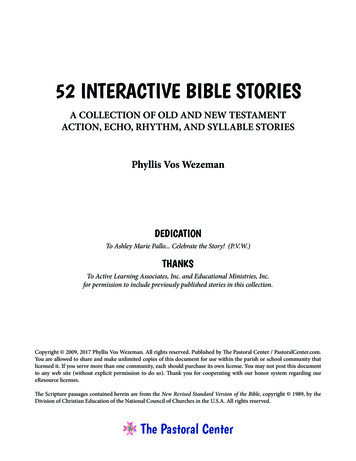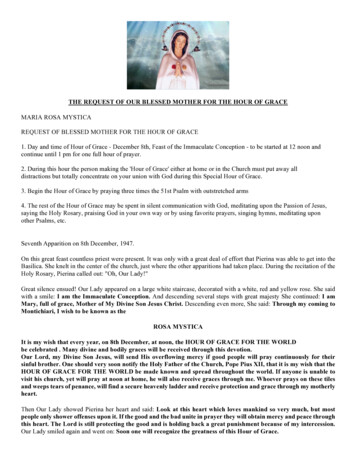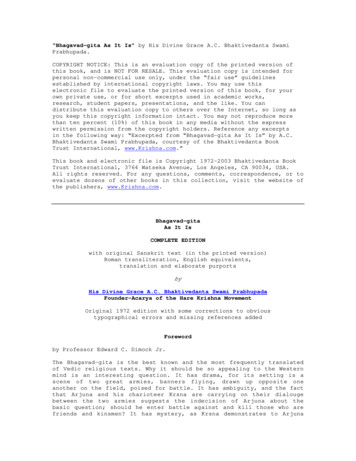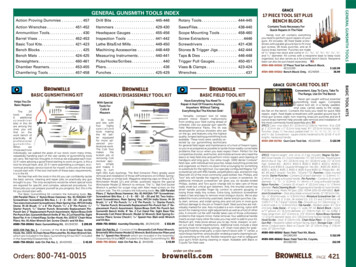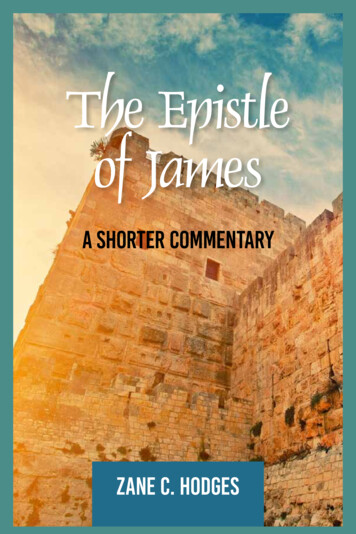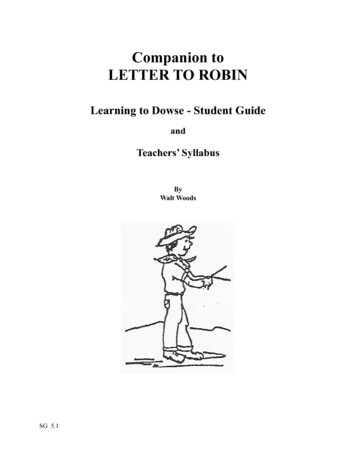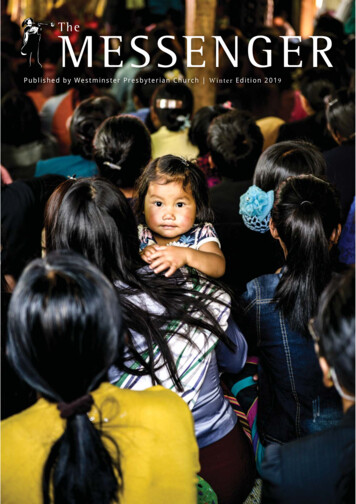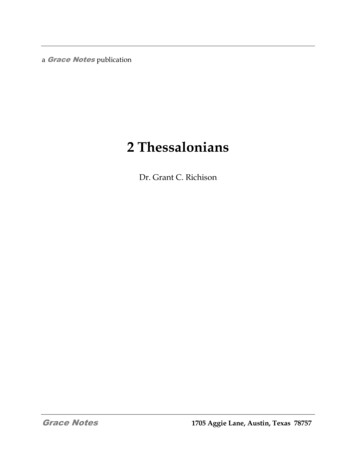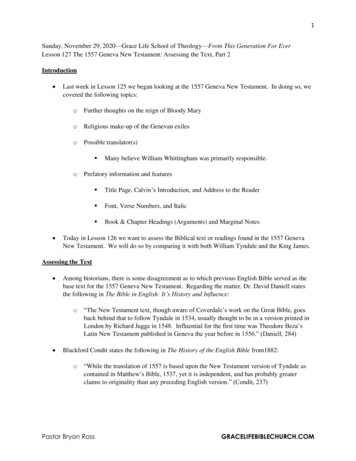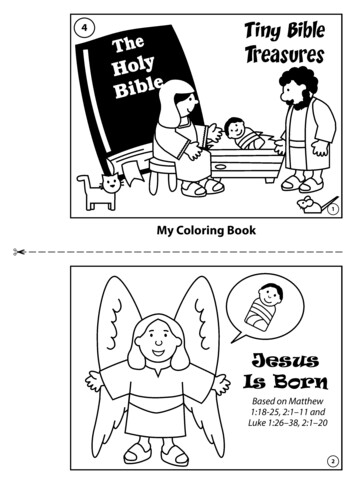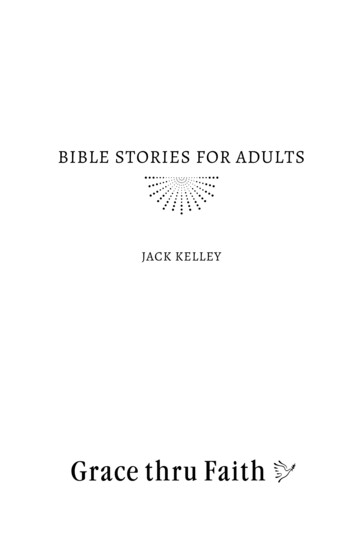
Transcription
BIBLE STORIES FOR ADULTSJACK KELLEY
B IBLE S TORIES —F OR A DULTSVOLUMES I & IIOLD & NEW TESTAMENT STORIESJ ACK K ELLEYgracethrufaith.com
Copyright 2017 by Grace thru Faith.All rights reserved. No part of this publication may be reproduced, distributed ortransmitted in any form or by any means, including photocopying, recording, or otherelectronic or mechanical methods, without the prior written permission of thepublisher, except in the case of brief quotations embodied in critical reviews andcertain other noncommercial uses permitted by copyright law. For permission requests,write to the publisher, addressed “Attention: Permissions Coordinator,” at the addressbelow.Grace thru FaithPO Box 189010-185Coronado, CA 92178www.gracethrufaith.comBible Stories for Adults / Jack Kelley. —2nd ed.ISBN 978-1978369962
CONT ENT SForewordIntroductionviiixPART ICreation Part 1: In the BeginningCreation Part Two: Let There Be LightAdam and EveCain and AbelNoah and the Flood Part OneNoah and the Flood Part Two: The Big BoatNoah and the Flood Part Three: Hidden in Plain SightThe Tower of BabelAbraham and Isaac: The Gospel in GenesisIsaac and Rebecca: The Gospel in Genesis Part TwoJacob and EsauJacob’s LadderJoseph and His Coat of Many ColorsMoses, the Prince of EgyptThe Passover: Exodus 12Crossing the Red SeaThe 10 CommandmentsAnd the Walls Came Tumblin’ DownThe Gospel in Joshua: The Story of RahabSamson and DelilahDavid and GoliathElijah on Mount CarmelThe Adversary Part One: The Shining OneThe Adversary Part Two: I Will Make Myself Like theMost High25. Three Boys in the Fiery Furnace26. The Handwriting On The 68185899499103107111
27. Daniel in the Lion’s Den28. Jonah and the Whale116120PART II29. The Birth of John the Baptist30. The Birth Of Jesus31. We Three Kings Of Orient Are32. The Temptation In The Wilderness33. Jesus Heals a Paralytic34. Water Into Wine35. Jesus Heals a Demon Possessed Man36. Jesus Heals a Leper37. The Kingdom Parables38. Jesus Calms the Storm39. Feeding the 5,00040. Jesus Walks on Water41. The Unmerciful Servant42. The Lost Sheep, the Lost Coin, and the Lost Son43. The Dead Girl and the Sick Woman44. The Workers in the Vineyard45. Two Sons and a Few Tenants46. The Good Samaritan47. The Rich Man and Lazarus48. The Wedding Banquet49. Raising Lazarus from the Dead50. Palm Sunday51. The Healing at the Pool52. Cleansing the Temple53. The Blind Beggar54. The Parable of the Ten Virgins55. The Parable of the Talents56. The Last Supper57. The Crucifixion58. The Resurrection and AscensionAbout the 6200204210214218223228232236240244249252256259263
FOREWORDMy husband Jack was an amazing Bible teacher. He had a gift ofmaking complex topics easy to understand, and communicatedGod's heart for His people in ways that profoundly influenced hisaudience.One of Jack's most popular series has been his Children’s Stories of theBible for Adults, Volume I.Shortly after publishing these Old Testament stories, we were calledto be missionaries in Mexico. (You can read the whole story on ourAbout page on gracethrufaith.com.)From the very beginning, our ministry focused on showing that theGod we serve is real, that He hears our prayers and answers them.We asked the Lord only to provide for our needs and the needs ofthose we served. And He provided abundantly. He is faithful!From Mexico, Jack published two other books, over 8,000 BibleQ&A posts, and over 1,000 Bible Study articles at gracethru‐faith.com. He taught and wrote prolifically, while we provided food,housing, medical care, and education for the poor. Jack was putting
viiiF OR E W OR Dthe finishing touches on Volume II, the New Testament stories,when he passed away in October 2015.In the two years since the love of my life went to his eternal home,the Lord continues to prove faithful. Jack's legacy lives on in histeachings on the site, and our outreaches continue to grow. We areable to do more to help those in need now than ever before. Asalways, we offer all of Jack's teachings free of charge. And we blessthose in need with what we're given.Now, I am so blessed to present to you Jack's teachings on the chil‐dren's stories in the Bible. In this new book, including Volumes Iand II—the Old Testament and New Testament—you’ll discoverhow the language, customs and culture of biblical times will helpyou grow in a more mature understanding of these timeless chil‐dren’s stories. I’m excited for you! The details and symbolism ofthese stories are about to make the Word of God come alive in yourheart. Prepare to have your faith strengthened as you grow closer tothe Lord.May the Lord richly bless you,Samantha Kelleygracethrufaith.com
INTRODUCTIONThe children’s stories of the Bible are often a child’s first glimpse ofGod, and the simple way in which they’re told is great for littleminds. Recent surveys show that most adults who call themselvesChristians still believe these stories from their childhoods to be true.But most of us have never heard the adult versions with their addi‐tional detail and background—information that not only enhancestheir validity but reveals additional insight into the characterof God.And for non-believers who’ve relegated them to the status of fairytales and fables, this additional background provides logical andrational reasons to re-think their decision and look at these chil‐dren’s stories again. As you’ll see, they’re actual events that describeGod’s earliest revelation of Himself to us.Here then, are the adult versions of the Bible’s children’s stories,with detail and background to support the fact that these storiesaren’t just a Biblical version of Aesop’s Fables. They reallyhappened, and for good reason. Over the decades I’ve beenstudying them, I’ve uncovered a wealth of information, which I’vepieced together into my view of the story behind each story. I hope
xI N T R OD U C T I O Nreading them will prompt more intense study on your part, to see ifthese things are true.For everything that was written in the past was writtento teach us, so that through endurance and theencouragement of the Scriptures we might have hope.(Romans 15:4)
PART IThe Old Testament
1CREATION PART 1: IN THEBEGINNINGW H AT H APPEN ED BETWEEN G EN E S I S 1 :1 AN D 1: 2?In the beginning God created the heavens and theearth. Now the earth was formless and empty, darknesswas over the surface of the deep, and the Spirit ofGod was hovering over the waters.And God said, “Let there be light,” and there waslight. God saw that the light was good, and heseparated the light from the darkness. God called thelight “day,” and the darkness he called “night.” Andthere was evening, and there was morning—thefirst day.And God said, “Let there be a vault between thewaters to separate water from water.” So God madethe vault and separated the water under the vault fromthe water above it. And it was so. God called the vault“sky.” And there was evening, and there was morning—the second day. (Genesis 1:1-8)
4BI B LE S T O R I E S F O R A D U LTSTH E S TOR Y B EHI N D THE STOR YA quick lesson in Hebrew is helpful to understand verse 1. TheBible uses three Hebrew words to describe creation events:1. Bara literally means to create and always refers to a direct work ofGod. It’s the word used in verse 1 and means to make something fromnothing.2. Asah means to make something from something else, and3. Yatsar means to form or fashion something as a sculptor or pottermight do.(Genesis 1:26-27 uses both bara and asah when speaking ofMan’s creation, and all three are used together in Isaiah 45:18concerning Earth.)Shamayim, translated heavens in verse one, is what we would callthe sky. The word is plural because it includes both the Earth’satmosphere and the vast reaches of space where the stars and othercelestial bodies reside. The Bible distinguishes between theatmosphere and the expanse of space, calling them the first andsecond heavens respectively. The third heaven is, of course, theThrone of God.When the Bible says the firmament separates the waters above fromthose below, the Hebrew word is raqiya. This is Earth’satmosphere—the first heaven.Before the Great Flood, this firmament supported a water vaporcanopy that enveloped the Earth and deflected harmful ultravioletrays preventing them from damaging life on Earth, hence the notionof separating waters above from those below.So the water vapor canopy separated the atmosphere from space—the first heaven from the second. It also made for a uniformly sunnysubtropical climate the world over with no variation in weatherpatterns. No rain, storms, floods or even heavy winds would haveoccurred on Earth before the Flood.
CR E A T I ON P A R T 1 : I N T H E BEG INNIN G5Verse 2 is a horse of a different color. Many scholars believe theverse should read, but the Earth became formless and void, an uninhabit‐able ruin. Apparently, combining a strict use of grammar with clari‐fying passages elsewhere in the Old Testament leads to a hint ofsome sort of judgment between verses 1 and 2 that left the Earth inshambles, an uninhabitable ruin.The controversy revolves around two issues:1. Whether the Hebrew requires an active (became) rather thanpassive (was) form and2. The Hebrew words tohu and bohu, translated formless and void.These words are found only in Genesis 1:2, Isaiah 45:18 andJeremiah 4:23. In the Isaiah passage, the Lord reveals that Hedidn’t create the world in vain (the Hebrew is tohu) but formed it tobe inhabited, thus supporting the idea that it became an uninhabit‐able ruin. And in a vision, Jeremiah saw Earth when it was formlessand void (tohu and bohu) in the context of a judgment.TH E G AP THEOR YViewed this way, the first two verses of Genesis would go somethinglike this:In the beginning, God created the Heavens and theEarth. As you would expect of God, everything Hecreated was complete, perfect and beautiful, ready forhabitation. But then something caused a judgment thatleft the Earth an uninhabitable ruin for who knowshow long. It was dark and wet and cold, but the Spiritof God never left the scene, and after some extendedperiod of time, God said, “Let there be light.”And so, what we know as the Creation account actually begins inverse 3.
6BI B LE S T O R I E S F O R A D U LTSThis view, known as the Gap Theory, helps solve the so-called “oldEarth young civilization” problem. It also reconciles several otherissues between creationists and other scientists. By the way, don’t tryto use the Gap Theory to explain fossils. Death came into the worldthrough sin, and that came after Adam and Eve arrived. Fossils wereformed only once in the Earth’s history, during the Great Flood.W H E RE D ID THE Y COME FROM?What could have caused such a judgment? Some rabbinical scholarscontend that the way the first letter was formed in the first Hebrewword of Genesis 1 warns us that nothing preceding it canbe known.Some hints, though, can lead us to informed speculation. Forinstance, in Job 38:7 we see the angels shouting for joy at theGenesis 1 creation events. Where did the angels come from?In Genesis 3 “the shining one” in the form of a serpent temptsAdam and Eve in the Garden. He’s described as a created being inEzekiel 28:13, but when was he created? And in Isaiah 14:12-20and Ezekiel 28:11-19 we read of a rebellion and judgment inHeaven.The King James identifies the one rebelling in Isaiah as Lucifer.From Ezekiel, we learn he was created as an anointed cherub, incharge of the guardians of the Throne of God, and a visitor in theGarden of Eden.Surely these are references to the rebellion, judgment, and fall ofSatan—events that began before the creation of man and willconclude at the end of the Millennium. Could they have alsobrought about a judgment of the Earth before Adam? Manyinformed scholars speculate just that.Speculation? Yes. Will we ever fully understand? Not until we get toheaven. But I think using the Bible as its own commentary presents
CR E A T I ON P A R T 1 : I N T H E BEG INNIN G7compelling, though circumstantial, evidence that favors the GapTheory. In the next chapter, we’ll look at the length of each creationday, discover why the Jews have always begun their day at sunset,and learn when time began.
2CREATION PART TWO: LET THEREBE LIGHTW H Y D O J EWISH DAYS BEG IN AT SU NS E T ?And God said, “Let there be light,” and there waslight. God saw that the light was good, and heseparated the light from the darkness. God called thelight “day,” and the darkness he called “night.” Andthere was evening, and there was morning—the firstday. (Genesis 1:3-5)S HEDDING SO ME L IGHT IN THE SU B J E C TI’ve begun this chapter with Genesis 1:3-5 because I believe this iswhere the creation account begins. How could there be light on DayOne when the sun and moon didn’t appear until Day Four? Like somany things, the answer lies in the Hebrew language.The word translated light in verse 3 is owr meaning illumination. Inverse 14, speaking of the sun and moon, the Hebrew word is
CRE A T I O N PA R T T W O: L E T T HE RE BE LIG H T9maowr meaning a luminous body, or light repository. The word literallymeans chandelier.In making the sun and moon, God was gathering the light intorepositories that would provide it according to schedule.Note that in referring to the sun and moon, the Hebrew word asah(to make something from something else) is used rather than bara (to createsomething from nothing).Like a chandelier, the sun and moon are not the light itself but weredesigned to hold, disperse, or reflect the light.G OD S PEA KS HEB R EWIn calling the light Day, He used the Hebrew word yom, a word thatappears 2,244 times in Scripture. 1,977 (over 88%) of those appear‐ances clearly refer to a 24-hour period. And simple observation of naturetells us the growth cycle of nearly every living thing
The children’s stories of the Bible are often a child’s first glimpse of God, and the simple way in which they’re told is great for little minds. Recent surveys show that most adults who call themselves Christians still believe these stories from their childhoods to be true. But most of us have never heard the adult versions with their addi‐ tional detail and background—information .
